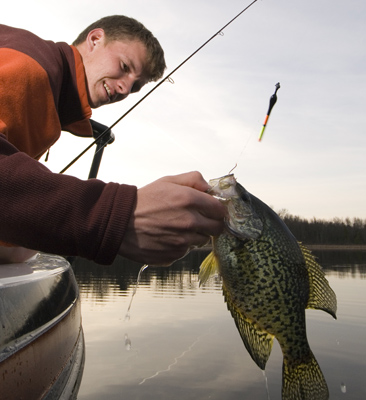by: Terry Tuma
With the fall equinox just a couple weeks away, fish already are entering that key transitional period on a waterbody near you. Here are some recent questions from readers that reflect this betwixt-and-between – albeit productive – time of year.
QUESTION: Where can I find big bluegills now, and what methods should I employ to catch them?
"TACKLE" TERRY TUMA:Monster ’gills will relate to deep water structure and edges in late summer. Using electronics, search sunken rock piles, sunken island edges, deep points, weedlines, and breaklines. Work these areas with jigs/Power Grubs or hair jigs. Add a medium leech or piece of crawler for added scent and taste. Another productive option is slow trolling spinner rigs with small crawlers or leeches along edges or structure. Tie your rig with 3 to 4 feet of fluorocarbon attached to a black barrel swivel and #0 Colorado blade, three beads, No. 8 hook and bottom-walking sinker. This is similar to spinner rigs for walleyes. It works.
Q: Does color really make a difference in catching fish?
TUMA: There have been several recent color questions, and yes, it is a factor. I have experimented with color for several years and still do. On a recent bass outing, it was amazing to see how one color outproduced all others with identical baits. However, vibration, movement, mood, size, depth, water temperatures and speed must first be determined. Of course, there must be fish in the selected area. Understanding what fish are feeding on and matching that color accordingly becomes a starting point. Don’t get hung up on this match-the-hatch concept. A splash of a contrasting color on lures or flakes in plastic create should-I-eat-or-not-eat interest.
Fish scrutinize color more than we realize. There are times when color is less important, but under most conditions it’s crucial, especially with fish in negative to neutral moods. There are no set guidelines that manufacturers must follow with specific colors, so “green pumpkin” can differ from one brand to another. Often, anglers do not want to invest the effort to change color because they believe it will not make a difference. One color can be good, but another may be better on a given outing. Via trial and error, it can or will change as the day progresses. Listen to the fish.
Q: Should I add a leader to Fireline while long-lining crankbaits for finicky autumn walleyes? What speed is ideal?
TUMA: Yes, attach four feet of 6- to 10-pound monofilament to Fireline with a small black barrel swivel to reduce line twist. Superlines do not stretch, but mono does – it acts as a shock absorber. That means fewer lost fish. Medium trolling speed varies from .9 to 2.1 mph. Troll too fast and lures spin out; too slow and you lose prime vibration. Pay attention to how the 7-plus-foot fast-taper rod tip is thumping. This indicates the most productive tempo. Let fish tell you what speed and profile they want.
Q: At what depth will I locate fall crappies? What baits do you suggest?
TUMA: In a few weeks, search for post-turnover, fall crappies suspended in 20- to 40-foot depths. But don’t overlook belly-to-the-bottom fish. Food sources and weather are key location ingredients. Present vertical jigs tipped with plastics and/or minnows. Employ a heavier jig for a faster drop to nab active feeders. Experiment with jigging action. Minimal jigging usually suffices. Slow trolled three-ways with short snells and minnows will catch bottom huggers. Don’t overlook shallow areas: green weed edges, rock piles, sandy shorelines, and long points extended to deep water. Bottom line: Every lake is different, and so are the slabs.
Q: I’ve been fishing hard all summer and noticing a lot of line twist on my spinning reels? What causes this?
TUMA: Old line, poor quality, overfilling the spool, casting into wind, and reeling in fish against drags are possible causes. But the main problem is loose line from improperly installed reels. Always position filler spools vertically and apply sufficient tension while filling reels. Line should come off filler spools and on reels clockwise. This eliminates looseness. Final note: Always follow manufacturer recommendations shown on reels.
Q: How do you store open-water rods and reels in winter?
TUMA: Always visually inspect rods and reels for wear, especially rod guides. Look for issues with drags, baits, or retrieves. If you see anything, clean or replace. Now is a great time to scrub rod handles to remove slime and dirt build-up. Use vertical or horizontal rod holders for even support. Avoid hanging from tip guide or stacking in a corner. Loosen reel drags to avoid rod tension, especially the upper half. You can remove old line now, but replace it just prior to open water. This is a fine time to inventory tackle. Remove lures that you aren’t using, and consider what to add for next open-water season.






